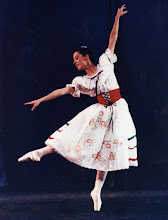My new site, Inside Ballet Technique, is now up and running! It's located at http://www.insideballet.com. It is basically this blog, whipped into shape. Please change your bookmarks and follow the new blog on Facebook--you can find the "Become a Fan" on the right sidebar of the web site.
Thanks!
Friday, November 6, 2009
Thursday, November 5, 2009
Dancers and Conditioning
I’ve often wondered how common it is for a dancer to suffer from chronic back pain during and after their dancing career. I personally had a lot of issues with low back pain while I was dancing, and I attributed much of it to the repetition of particular moves in choreography and to the fact that I have a long torso (which in my mind was not conducive to dancing ballet). Now that I’m suffering the long term effects of chronic back pain and getting older, I’m realizing that there were things I should have been doing to supplement my core strength in order to counterbalance the excessive flexion that dancing demands. It never occurred to me that dancing ballet six or more hours a day was not enough.
I knew that if I did crunches and stretched out before class that I would perform extensions and hold balances better, but I didn’t focus enough on really strengthening my abdominals, my back, and stretching out my hamstrings the way I should have. Not only that, I have since learned that aerobic or cardio training could have helped my dancing as well. An article from the Harkness Center for Dance Injuries web site states, “Aerobic fitness can increase blood flow and oxygenation to all tissues, including the muscles, bones, and ligaments of the spine. Dancers should be encouraged to cross-train year round to maintain aerobic fitness.”
Sean Fyfe is a physiotherapist working with Metis Physio Centres in London, a multi-disciplinary clinic and he works with elite dancers and theatre performers. From an article at sportsinjurybulletin.com, he says, “Dancing alone doesn’t ensure abdominal strength, good activation through glut max or activation of segmental stabilisers. In that respect, dance is no different from any other sport: its performers have to put aside the time to do specific body maintenance, in conjunction with regular screening, to give themselves the best chance of remaining injury free.”
I have begun taking yoga classes and wish I’d known the value of yoga and Pilates back when I was dancing. The mindfulness (or meditation) that comes out of practicing yoga is giving me tools that allow me to be a calmer, happier person—more capable of administering to the needs of my my family or coworkers and simply being able to breathe and be in the moment. At yogamindfulness.com, they explain that meditation doesn’t have to be something you hole up alone in a quiet room to do; it can be done just by being mindful and living in the present. Visualizing breath as it enters and leaves the body, noticing the state of your body at any moment in time, using your senses fully to take in the world around you—any of these can be a form of meditation.
Dancers are focused so much on their bodies, and I personally think it would do a world of good for them to also nurture their minds and spirits in a holistic way. We used to make fun of the modern dancers and called them “granola” people for the way they utilized breath and didn’t attempt to hide the effort in their movements. Now I see that they were really onto something that ballet dancers would do well to heed, too. Not that ballet dancers will ever want to enunciate their breathing on stage, but I think it would be great if teachers taught their students to breathe in and out with the counts during class, much like they do in yoga. With age cometh wisdom, and hindsight is always 20/20, right?
Here is a great book for dancers with information about anatomy and kinesiology.
Tuesday, November 3, 2009
Monday, November 2, 2009
Subscribe to:
Comments (Atom)







